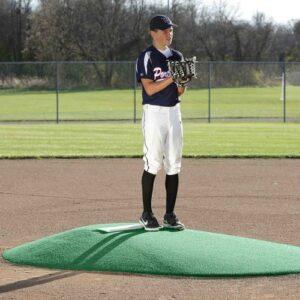
When running instructional clinics for young players I am often asked by coaches and parents “When should my son or daughter start throwing a curveball?” This is a difficult question to answer. There is no specific moment when a coach or parent will say, “my son or daughter is ready now.”
I would recommend waiting until the player is 14 or 15 years old. If young players throw curveballs on a consistent basis at younger ages they can cause damage to their elbows and thus hinder the growth process.
But it’s not only the fact that they are throwing curveballs at a young age, it’s the fact that they are throwing curveballs with improper mechanics that causes much of the damage. MAKE SURE THEY ARE THROWING THE PITCH WITH PROPER MECHANICS!
The mechanics of a curveball are NOT the same as a fastball. There are several key elements to the curveball that must be followed in order to throw the pitch properly:
- GRIP: The key finger in a curveball is the middle finger. Ideally the pitcher will find a grip where seam will provide resistance against that middle finger during the release. That is how the curveball gets its tight rotation.
- STRIDE: If you find that one of your pitchers is having difficulties getting on top of their curveball (pitch constantly coming out high), get them to shorten their stride by 2-4 inches.
- ELBOW: The throwing elbow must be equal to or slightly above the throwing shoulder. As soon as the pitcher lowers the elbow below the shoulder, they put additional stress on that arm. The angle of the elbow joint should be no more than 90 degrees. Pitchers who throw curveballs at angles greater than 90 degrees may put additional stress on their throwing shoulder.
- PATH: The path of the ball on a fastball is generally far from your head. In the case of a curveball, the path will be much closer to your head (slightly up and away from your ear).
- RELEASE: Releasing a curveball is much different than releasing a fastball. A fastball release is straight out in front of your body. In effect, the way you release the ball is the type of action you want the pitch to have. When releasing a curveball, your wrist will be hooked and your hand will pull down in front of your body. It is important that you release the ball close to your body (Short Arm). The further you release from your body, the less resistance your middle finger will have on the seam and therefore your rotation will be looser. Loose rotation curveballs tend to spin or hang.
- ARM SPEED: It is extremely important that you maintain similar arm speed with your curveball that you have with your fastball. A hitter reads arm speed. The matter of arm speed is obviously more important with a changeup than it is with a curveball, but it’s important for other reasons. Another way to get a tight rotation and hard downward movement with a curveball is to throw it with quicker arm speed. If two pitchers have the exact same curveball grip, mechanics, release, etc. but one throws it with quicker arm speed, the one with quicker arm speed will throw the curveball with more break, and thus the harder pitch to hit.

Andrew Tinnish is now the Toronto Blue Jays Assistant General Manager after years learning & working his craft from the Assistant of Amateur Baseball Operations he was when we met.
He was hooked on the game at a young age and had success as a college & professional pitcher for the Northern League’s Quebec Capitales, compiling a 3-1 record. He has been credited with drafting Aaron Sanchez, Noah Syndergaard, Marcus Stroman, Anthony Alford & Daniel Norris and also played a role in signing Vladimir Guerrero Jr…. some guys just have an eye for real talent.
-
Product on saleThe Original Pitchers Pocket Pitching Target With Team Color Pro Padding!Original price was: $359.00.$324.95Current price is: $324.95.
-
Our Economical Pitchers L Screen | 7′ x 7′ With Large 3.5′ x 3.5′ CutoutPrice range: $279.00 through $559.00
-
Product on sale10″ Portable Pitching Mound | 2 Game Sizes | Made In USA QualityPrice range: $4,290.00 through $4,390.00




